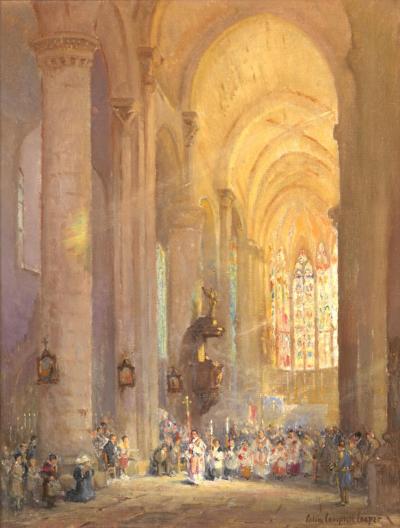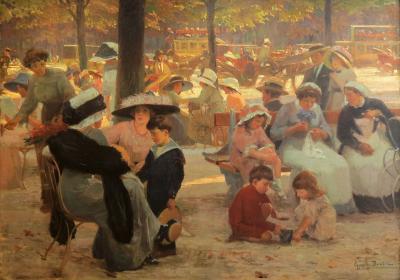Impressionist Colin Campbell Cooper
From the archives: This article was originally published in the Spring 2007 issue of Antiques & Fine Art magazine; AFA is affiliated with Incollect.
A painter of appealing impressionist works who is best known for his vibrant early-twentieth-century cityscapes, Colin Campbell Cooper has long been popular among collectors. The son of a well-to-do Philadelphia surgeon, Cooper studied under Thomas Eakins at the Pennsylvania Academy of Fine Arts. He began spending long stretches of time abroad after about 1885, and much of his early work focuses on the architecture and scenery he encountered in his travels through Holland, Belgium, Spain, Italy, and France (Fig. 1). It was in Europe that Cooper’s enduring interest in architecture took hold, and his views of centuries-old cathedrals and townscapes anticipate the magnificent skyscraper works that would bring him his greatest fame.

-
Fig. 1: Colin Campbell Cooper (1856–1937), Concarneau, 1890. Oil on canvas, 19-1/2 x 28 inches. Courtesy of Vincent Vallarino Fine Art, New York.
After his 1897 marriage to Emma Lampert (1855–1920)—an accomplished artist in her own right—Cooper’s interest gradually shifted to American subjects, though he continued to paint and travel abroad until almost the end of his life. In 1904, he established his base in New York, where his midtown studio location offered him ample opportunity to observe firsthand the dawn of New York’s skyscraper era. Though Cooper’s New York works (Figs. 2, 3) were largely created at the same place and time as those of the Ashcan School artists, Cooper’s light- and color-filled urban scenes celebrated city life and the forward march of progress rather than emphasizing its grittier side.
Cooper’s celebrated views of skyscrapers and New York landmarks are also his most sought after by collectors.Though most closely linked with New York and, after 1921, California, Cooper also produced views of other American cities at the turn of the twentieth century: Chicago, Philadelphia, Washington, D.C., Pittsburgh, and Emma Lampert Cooper’s native Rochester, New York, which he considered his second home. In addition, he worked extensively in watercolor (Fig. 4), often exhibiting highly finished works of the same subjects he would later depict in oil.
Cooper's exceedingly rare southwestern scenes are highly desirable, given the avid interest in Taos works by any artist, as are his Orientalist views resulting from Cooper’s 1913–1914 trip to India. Still other less familiar areas of Cooper’s oeuvre include engaging views of the historic architecture in cities such as Annapolis, Richmond, Charleston, Savannah, Salem, Newport, and on the islands of Nantucket and Martha’s Vineyard.
Cooper’s trip to the 1915 Panama-Pacific Exposition in San Francisco resulted in a fascinating series of works that depict the various buildings created for the fair (Fig. 5), and his travel to southern California afterward undoubtedly stirred the interest that culminated in his permanent move there after Emma’s death in 1920. In Santa Barbara, Cooper enjoyed a second act in his career, delving into new subject matter, serving as leader of the local art community, and writing plays, a number of which were produced for the stage during his lifetime. Working with renewed creative vigor, Cooper produced a body of work that includes not only dazzling views of the area’s gardens (Fig. 6) and local architecture, but also a return to the figural painting for which he had earned early praise but had all but abandoned in his New York period. Ray Redfern of the Redfern Gallery in Laguna Beach, who has handled Cooper’s work for over thirty years, considers him one of the top five California artists, due to the quality and consistency of his work. “Cooper has always had a huge following among California collectors,” Redfern remarks. "The California works turn up, but not in great quantity.” Collectors prize site-specificity in Cooper’s California paintings, according to Redfern.
This archive article was published in association with a 2007 retrospective exhibition that traveled among the Hecksher Museum in Huntington, New York, the Laguna Museum of Art in California, and the Irvine Museum: East Coast/West Coast and Beyond: Colin Campbell Cooper, American Impressionist. The catalogue was written by William Gerdts and Deborah Epstein Solon. The catalogue illuminates some heretofore unexplored facets of the artist’s life that offer collectors some intriguing areas to pursue. For instance, Cooper visited Taos in 1881, and was among the first painters to discover this now-legendary New Mexico art colony.
-----
Lisa Bush Hankin is director of research at Adelson Galleries in New York, where she specializes in nineteenth- and twentieth-century American fine art.




































